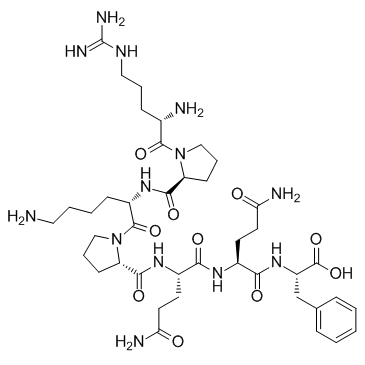Substance P (1-7)

Substance P (1-7) structure
|
Common Name | Substance P (1-7) | ||
|---|---|---|---|---|
| CAS Number | 68060-49-1 | Molecular Weight | 900.03600 | |
| Density | N/A | Boiling Point | N/A | |
| Molecular Formula | C41H65N13O10 | Melting Point | N/A | |
| MSDS | Chinese USA | Flash Point | N/A | |
|
Effects of L-glutamate, substance P and substance P(1-7) on cardiovascular regulation in the nucleus tractus solitarius.
Regul. Pept. 46 , 102, (1993)
|
|
|
Endomorphin-1 and endomorphin-2 differentially interact with specific binding sites for substance P (SP) aminoterminal SP1-7 in the rat spinal cord.
Peptides 27 , 753-759, (2006) Endomorphin-1 (EM-1) and endomorphin-2 (EM-2) represent two opioid active tetrapeptides with high affinity and selectivity for the mu-opioid (MOP) receptor. Both EM-1 and EM-2 exhibit strong inhibition of pain signals in the central nervous system (CNS). In c... |
|
|
Substance P(1-7) induces antihyperalgesia in diabetic mice through a mechanism involving the naloxone-sensitive sigma receptors.
Eur. J. Pharmacol. 626 , 250-255, (2010) We have recently explored the role of the tachykinin substance P neuroactive fragment substance P(1-7) in the mediation of anti-inflammatory effects using a blister model in the rat paw (Wiktelius et al., 2006). We observed that this heptapeptide induced a do... |
|
|
The C-terminal amidated analogue of the substance P (SP) fragment SP(1-7) attenuates the expression of naloxone-precipitated withdrawal in morphine dependent rats.
Peptides 30 , 2418-2422, (2009) We previously demonstrated that intracerebroventricular (i.c.v.) administration of the substance P (SP) aminoterminal fragment SP(1-7) attenuates the expression of morphine withdrawal in the male rat. In this study we have used a synthetic analogue of this pe... |
|
|
The substance P (SP) heptapeptide fragment SP1-7 alters the density of dopamine receptors in rat brain mesocorticolimbic structures during morphine withdrawal.
Peptides 25 , 1951-1957, (2004) The aminoterminal fragment of substance P (SP), SP(1-7), has been suggested to modulate the expression of opiate tolerance and withdrawal behaviors in rodents. However, the mechanism of this effect is not yet clarified. Using a rat model we have previously de... |
|
|
Substance P N-terminal fragment SP(1-7) attenuates chronic morphine tolerance and affects dynorphin B and nociceptin in rats.
Peptides 32 , 1661-1665, (2011) The N-terminal substance P fragment SP(1-7) is known to modulate hyperalgesia and opioid withdrawal in animal models. This study examined the effects of intraperitoneal (i.p.) injections of SP(1-7) on chronic morphine tolerance and on the levels of dynorphin ... |
|
|
Inhibition of ERK phosphorylation by substance P N-terminal fragment decreases capsaicin-induced nociceptive response.
Neuropharmacology 61 , 608-613, (2011) Previous research has demonstrated that substance P N-terminal fragments produced by the action of several different enzymes in the spinal cord could reduce nociception when injected intrathecally (i.t.) into mice. The present study examined the possible invo... |
|
|
Injection of substance P (SP) N-terminal fragment SP(1-7) into the ventral tegmental area modulates the levels of nucleus accumbens dopamine and dihydroxyphenylacetic acid in male rats during morphine withdrawal.
Neurosci. Lett. 320 , 117-120, (2002) The biologically active substance P (SP) N-terminal metabolite SP(1-7) has been reported to modulate several neural processes such as learning, locomotor activity and reaction to opioid withdrawal. Although all these processes are believed to be associated wi... |